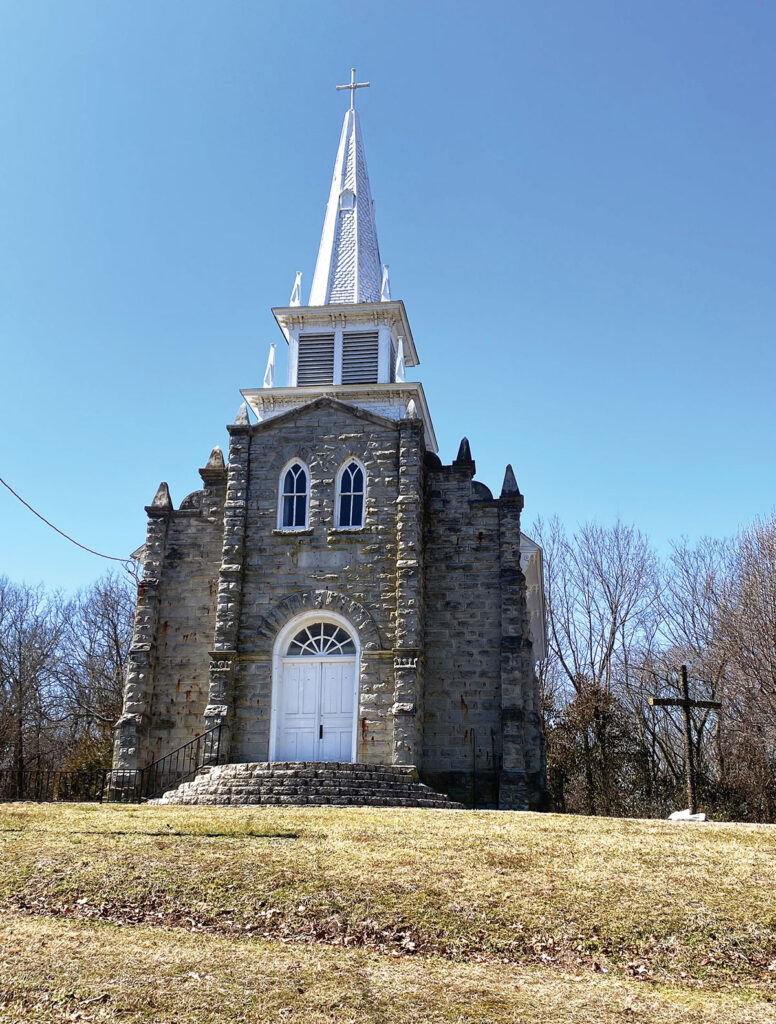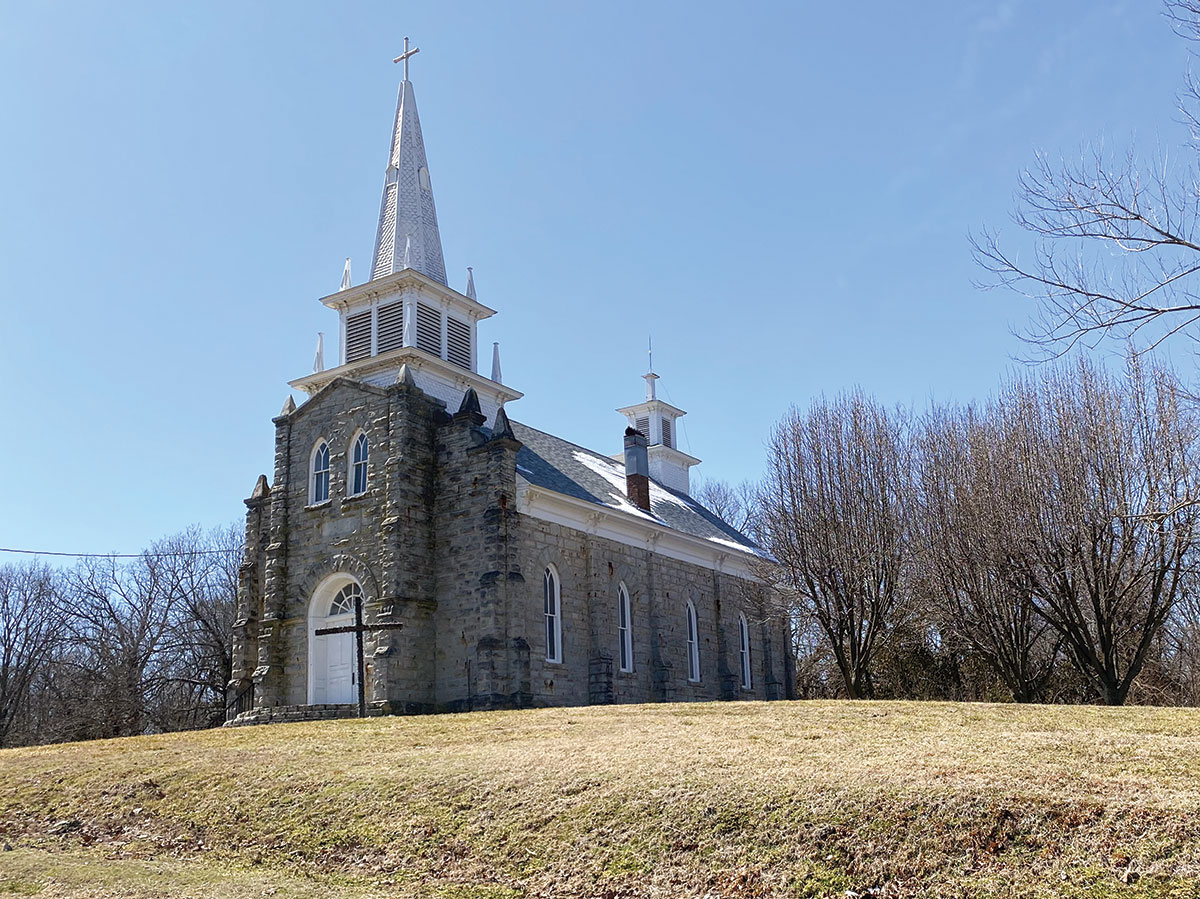
Cayuga Splitlog Mission Church was constructed by the Seneca Tribe Chief Mathis Splitlog
GROVE, OKLA. – Nestled near the Elk River and Grand Lake in Grove, Okla., amid acres of lush foliage, tourists to the area are often surprised to find a century-old stone church among the lake cabins and boats sitting on top of a hill.
The gray limestone church’s steeple is tall enough to be seen almost a mile away.
Cayuga Splitlog Mission Church and its picturesque cemetery is a hidden gem.
Visitors walking among the cemetery’s mid-1880 grave markers may see a doe and her fawn grazing nearby or a mischievous raccoon stealing a flower off a grave.
Mathias and Eliza Splitlog built Cayuga Splitlog Mission Church. It is considered the only church in Oklahoma, and perhaps in the United States, which was built solely by a Native American with his own funds for the religious use of all people.
Mathias Splitlog, also known as the “Millionaire Indian,” built the church out of love for his wife. But the church became a symbol of love between Mathias and his Creator, as well.
Chief Splitlog was the Principal Chief of the Wyandotte (Huron) tribe before their removal from Canada to Ohio. One son, Mathias Thomas Splitlog, was born in 1821 on the Wyandotte Reservation, now known as Anderdon, Ontario, Canada. He married Eliza Charloe Barnett in 1847, the great-niece of Chief Henry Jacques of the Wyandotte Tribe in Ohio, according to family historical documents.
Mathias Splitlog was ceremonially adopted into the Seneca Tribe in 1870 and later became their Chief.
Gifted with a bright mind, Splitlog would often watch and study the steam engine and soon mastered its principles. By studying the machinery, he could soon build a replica that powered a boat he and his brother built as they engaged in trade in the Great Lakes area, according to historical documents.
Always the entrepreneur, Splitlog built a sawmill, gristmill and another steamboat that journeyed on the Missouri River, eventually making Splitlog a wealthy man.
The family moved to Indian Territory, now known as Delaware County, and built a sawmill, a buggy factory, and a general store. The area became known as Cayuga Springs, according to Splitlog family documents.
Not known as a religious man, Splitlog would often allow his general store to serve as a church Sunday morning. Father Ketchum, a Roman Catholic priest, converted the Splitlogs to Catholicism, and in 1886, Splitlog began plans for a church to be built south of the buggy factory.
Ketchum helped design the church and used limestone that was plentiful in the area.
The church was decorated inside with hand-carved, imported wood. At the front of the church is an elaborately carved piano, which sits silently due to years of abandonment.
Outside, the name “Splitlog” is spelled out, one letter over each arched, stained-glass window. The arch forming the doorway to the church is constructed with 15 stones, each carved with an Indian symbol.
Eliza Splitlog died in 1894, and her funeral was held in the unfinished church, with her final resting place on the grounds near the church. The church was completed and dedicated Nov. 25, 1896, as St. Mathias Catholic Church. Included in the dedication ceremony was a tribute to Eliza Splitlog that included the ringing of a bronze bell.
On Dec. 22, 1896, Splitlog began what would be his final journey to Washington, D.C., on behalf of the Seneca Tribe. While en route, he fell ill, and soon after his arrival in Washington, he developed pneumonia and died on Jan. 1, 1897. His body was returned to Cayuga, where Mass was celebrated Jan. 14, 1897, in the same stone church he and Eliza had built. He was buried in the cemetery that adjoins the church.
For many years, the church was unused. Later, the church served as a school, then was abandoned and fell prey to vandalism. The bronze bell that had been cast in Belgium and once summoned its congregation to the old stone church was transferred to St. Catherine’s parish in Nowata.
The Catholic diocese sold the building to the Cayuga Methodist Episcopal Church Methodist Church in the early 1930s. It was later sold to R.A. Sellers Sr., whose family owns a lake home near the church.
The Sellers family has repaired the church throughout the years and has made provisions for care of the church and adjoining cemetery, including returning the bell to Cayuga Splitlog Mission Church with the help of Grover Splitlog, a grandson.
The old, tarnished bell now is in the front yard of the church’s groundskeeper.
On Oct. 16, 1972, the church was placed on the National Register of Historic Places.
For many years, bells rang out over Grand Lake as a group forming the Grand Lake Ministries began to hold services from May until September for tourists. In 1998, the group disbanded; however, several residents from the area met with the Sellers family, and with the family’s blessing, Cayuga Mission church was opened year-round.
Services are 8:30 a.m. on Sunday.







